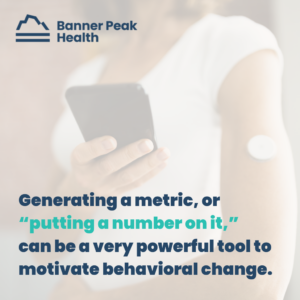
In earlier blog posts, I’ve discussed the concept of Metric-Derived Empowerment Cycles (MDECs).
Measurement devices now provide actionable data that incentivize and track the results of healthy behaviors. It can be a long journey from thinking about behavior change to initiating change to sustaining it. That’s human nature. We need all the help we can get.
Generating a metric, or “putting a number on it,” can be a very powerful tool to motivate behavioral change by quantitating a baseline and providing a measurable path to improvement. Continuous glucose monitors enable one of the most valuable MDECs we use at Banner Peak Health.
Chronically elevated blood glucose levels are associated with the development of diabetes, which elevates the risk for a wide range of illnesses, including heart disease, stroke, cancer, and kidney disease. The root causes of elevated glucose are multifactorial and include diet, stress, exercise, and sleep. The physiology of blood glucose is very complex.
What Is a Continuous Glucose Monitor?
The ability to measure glucose levels has come a long way since the days when practitioners would taste urine to detect sweetness, indicating excess sugar excretion. (The term diabetes mellitus is derived from Greek diabetes, meaning to pass through, and from Latin mellitus, meaning honey or sweet.)
By the 1840s, tests using chemical reagents could detect sugar in urine. By 1913, blood glucose levels could be measured in a lab. By the 1960s, blood glucose could be semi-quantitatively measured using a chemical test strip reacting with a drop of blood, though the process was cumbersome and not available for home use.
The true revolution in blood glucose monitoring came in the 1980s with the advent of handheld glucometers and reagents on test strips, allowing convenient self-monitoring. There were still significant constraints, however. One-time-use test strips were expensive, and the process of poking and testing was painful and time-consuming. Only the most dedicated of patients could comply with a two- to four-times-a-day testing regimen.
The technology in continuous glucose monitors, such as the current models, the Dexcom G7 and Freestyle Libre, has progressively improved over the last 15 years. The monitors have a very small tube, or cannula, that inserts into the subcutaneous region under the skin. The probe contains enzymes that generate an electrical signal proportional to the concentration of glucose in the interstitial fluid. Strictly speaking, blood glucose is not being measured directly. However, in most circumstances, the interstitial fluid is very close to the blood glucose level, with current models accurate to less than 10% deviation from blood levels.
The sensor remains attached to the skin for 10–14 days, depending on the model, and sends the results to a smartphone for patient viewing and subsequent transmission to a healthcare provider.
Modern Continuous Glucose Monitoring
The cost and complexity of early continuous glucose monitors relegated their use to the most complicated diabetic patients — those requiring insulin therapy and at greater risk for dangerously high and low levels of blood glucose. Today, the devices are also used for less complicated diabetic patients. They still require a prescription, however.
Just this year, Dexcom released a model, Stelo, that will be approved for sale without a prescription. It offers the same accuracy as their prescription model, the G7, but won’t be approved for those requiring insulin treatment.
The less expensive and more widely available Stelo model opens the way for continuous glucose monitoring to move from treatment of diabetes to prevention of diabetes.
Diabetes represents an unfortunate culmination of many years of progressive metabolic dysfunction. This lengthy process presents ample opportunity to modify behavior and prevent the onset of diabetes.
In medicine 2.0 (disease treatment), medications are the dominant treatment modality. In contrast, medicine 3.0 (disease prevention) relies predominantly on lifestyle choices — how you eat, sleep, exercise, and manage stress. Continuous glucose monitors, once relegated to the realm of medicine 2.0, are now poised to realize their full potential as a powerful tool for medicine 3.0!
Who Should Use a Continuous Glucose Monitor?
As part of screening blood tests, you’ve most likely had your fasting blood glucose level and possibly hemoglobin A1c (HgbA1c) measured. A fasting (12 hours without eating) blood glucose level can indicate your risk of diabetes:

Your HgbA1c level reflects your average glucose level over the past three months (see footnote 1) and is expressed as a percentage:

An elevated fasting blood glucose or HgbA1c indicates that you are at increased risk of developing diabetes or that you have diabetes. And these aren’t rare findings. An estimated 40 million adults in the U.S. have diabetes, and close to 100 million have prediabetes.
Several classes of medications can reduce the risk of progressing from prediabetes to diabetes as well as treat existing diabetes. However, the underlying causes of diabetes — insulin resistance, excess caloric intake, reduced exercise, and fat deposition — are best treated by reversing the lifestyle choices that created them in the first place. Medication can provide a backup safety net if lifestyle modifications don’t create enough benefit.
Continuous glucose monitoring offers a vital monitoring tool for anyone with borderline or elevated fasting blood glucose and HgbA1c levels to better understand their body’s unique physiology and guide lifestyle modifications.
How to Use Data From Continuous Glucose Monitoring
People often have an overly simplified understanding of blood glucose, envisioning a straightforward pipeline from the gut to the blood. Sugar goes in one side and comes out the other. The reality is much more complex.
I envision blood glucose as analogous to a beach ball, surrounded by multiple foam pellet guns bombarding the beach ball with shots of varying intensity from different directions. The movement of the beach ball is determined by the net effect of all the pellet guns. Some of these “pellet guns” are:
- Physical activity — Increased muscle cell usage consumes more glucose.
- Stress — Increased hormone levels of adrenaline and cortisol raise glucose.
- Illness — Infections increase adrenaline and cortisol, which raise glucose.
- Sleep deprivation — Lack of sleep increases adrenaline and cortisol, which raise glucose.
- Meal timing — Longer duration between eating reduces glucose levels.
- Medications — Some medications, such as glucocorticoids, can markedly raise glucose; others, such as thiazide diuretics and statins, can subtly raise glucose.
- Food intake — Certain foods raise glucose more rapidly; individual responses to different foods can vary considerably.
By wearing a continuous glucose monitor, you can learn about the unique effect of all these variables and more on your personal glucose levels.
Those using continuous glucose monitors to reverse prediabetes most commonly use them for several months.
The first step involves understanding the magnitude of the problem. Knowing your blood glucose level every five minutes, 24/7, provides a much more nuanced understanding of your metabolism than a one-time fasting level or an average level over 90 days.
The second step involves identifying the unique variables that influence your blood glucose levels. What happens after a fight with a family member, a poor night’s sleep, a head cold, a long hike, or a particular type of meal?
A big part of this learning process involves your response to different foods. Yes, a sugary soda will generate a rapid blood sugar spike in most people. However, we’re learning that there exists much greater variation in individual responses to different foods than previously thought. You may process a sweet potato very differently than someone else.
The third step involves using the continuous glucose monitor to track the progress of your behavior modifications. Basically, you run a set of experiments on yourself. What happens if you go to bed an hour earlier, meditate, eliminate a bedtime snack, eat brown rice instead of white, cut out soda and juice, or vary the carbohydrate content of your meals? Once you learn how you respond, you can change your habits and see the benefits.
Often after a month or two, the law of diminishing returns kicks in and the rate of new knowledge declines. If successful, you reach a new equilibrium of behaviors and maintain your blood glucose at a healthier level. You won’t need continuous glucose monitoring in the long term.
Some people may require more time or another round of usage. However, for those without medication-treated diabetes, the process should be relatively brief.
Final Thoughts
We’re living amid a silent epidemic of metabolic dysfunction. Many diabetics, and the vast majority of those with prediabetes, are unaware of their status.
At Banner Peak Health, we’re careful to identify risk factors like prediabetes and diabetes and are very aggressive in working with patients to mitigate their risks. Continuous glucose monitoring provides patients with a powerful tool to learn about their unique glucose metabolism and guide them to better health.
Footnote:
1. HgbA1c measurement relies on an interplay between red blood cells and glucose in the blood. Hemoglobin is a large, complex protein that binds iron and carries oxygen in the blood. Red blood cells are packed with hemoglobin, allowing them to transport oxygen throughout the body.
Red blood cells last about three months before they’re degraded, and their hemoglobin is broken down and recycled. Glucose sticks to hemoglobin molecules in a dose-dependent fashion. The higher the concentration of glucose, the more of it will stick to hemoglobin.
HgbA1c reflects the percentage of hemoglobin molecules with glucose stuck to them. Because red blood cells and the hemoglobin within them only last around 90 days, HgbA1c reflects an average level of glucose in the blood during that time.

Barry Rotman, MD
For over 30 years in medicine, Dr. Rotman has dedicated himself to excellence. With patients’ health as his top priority, he opened his own concierge medical practice in 2007 to practice medicine in a way that lets him truly serve their best interests.




